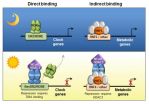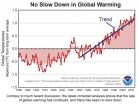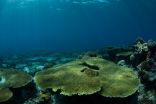Few opportunities to change
Ocean warming and oxygen loss are putting marine life under more and more pressure
2015-06-04
(Press-News.org) If you want to live, you need to breathe and muster enough energy to move, find nourishment and reproduce. This basic tenet is just as valid for us human beings as it is for the animals inhabiting our oceans. Unfortunately, most marine animals will find it harder to satisfy these criteria, which are vital to their survival, in the future. That was the key message of a new study recently published in the journal Science, in which American and German biologists defined the first universal principle on the combined effects of ocean warming and oxygen loss on the productivity of marine life forms. Their conclusion: as climate change progresses, these animals will be hard-pressed to satisfy their oxygen and energetic requirements in their changing native habitats. As a result, these species will migrate to cooler regions or deeper waters, ecosystems will be disrupted, and the diversity of species will decline.
In order to be able to make more precise and globally applicable prognoses concerning the effects of climate change on life in our oceans, marine biologists have long sought to find universal principles that would allow them to describe the living conditions in the oceans and at their borders. In this regard, one of the key questions is: How will the warming of the oceans and resultant decrease in dissolved oxygen impact marine life forms' productivity? As marine biologist Prof Hans-Otto Pörtner from the Alfred Wegener Institute, Helmholtz Centre for Polar and Marine Science, who co-authored the article, explains, "If an animal has to do more work, it costs energy that it somehow has to produce over and above its resting metabolic rate. Marine life forms generate this additional energy by breathing and thereby taking up more oxygen. However, their ability to do so depends on two factors: the water temperature, and how sensitive the species is to lack of oxygen."
In their new study, he and his American colleagues Curtis Deutsch, Brad Seibel, Aaron Ferrel and Raymond B. Huey calculated the ability of selected animal species to increase their metabolic rate, then examined that ability in relation with the temperatures and oxygen concentrations in the world's oceans. This approach allowed them to create a metabolic index for each species, which sets clearly defined limits for oxygen-breathing sea life: "Marine animals like eelpouts, rock crabs and Atlantic cod can only survive in environments with enough oxygen for them to increase their metabolism to between two and five times their resting metabolic rate if need be. Every species has a certain maximum temperature to survive, and a certain minimum oxygen level, and the two requirements are related," says lead author Curtis Deutsch from the University of Washington.
As such, the ongoing climate change poses the following problem for marine animals: the warmer the water gets, the less oxygen it can absorb and store. At the same time, in warmer water the animals will need more energy and oxygen to maintain their resting metabolic rate. This means the warmer the oceans become, the less able its inhabitants will be to boost their metabolism to between two and five times their resting metabolic rate, which is what allows them to move, seek food and reproduce. "If the oxygen level in a given region of the ocean drops below a species' minimum requirements, it forces the animals to abandon their native habitat. This combines with the effect of warmer temperatures. Since animals evade to cooler regions, their habitat shifts towards the poles or to greater water depths. In Atlantic cod and many other fish species, we can already observe the shift now," says Hans-Otto Pörtner.
In their study, the authors provide habitat-shift prognoses for all latitudes. As Hans-Otto Pörtner adds: "Further, the phenomenon is even more pronounced in those regions hit by additional oxygen loss, for instance due to increasing water stratification or because human beings release more nutrients into the ocean, promoting the growth of oxygen-stealing microorganisms."
The researchers expect to see the most apparent changes in the polar seas. "The water in the Arctic and Antarctic Oceans is extremely cold, but also very rich in oxygen. Thanks to evolution, the animals living there have adapted to these conditions and will have little chance to adjust when the combination of warming and lower oxygen levels hits. Instead, species that immigrate from areas with higher water temperatures and lower oxygen concentrations will establish themselves and displace the native polar species," says Hans-Otto Pörtner.
In the northern Pacific, for example, researchers are already observing a more extreme drop in oxygen concentrations than was expected due to warming alone. In this type of ocean region, the species' geographic range is reduced drastically, which of course also means significant consequences for the fishing industry.
From a research perspective, the new metabolic index concept can potentially facilitate better prognoses. "We now have a universal approach that allows us to more precisely identify climate-related changes in the geographic range and productivity of a given species," explains Hans-Otto Pörtner. Now it's up to the scientific community to investigate the metabolic index and its limits for further species; if they do, Pörtner is confident that: "Bit by bit, we'll arrive at a far more complete image of what we outlined in our study."
INFORMATION:
ELSE PRESS RELEASES FROM THIS DATE:
2015-06-04
From a single drop of blood, researchers can now simultaneously test for more than 1,000 different strains of viruses that currently or have previously infected a person. Using a new method known as VirScan, researchers from Brigham and Women's Hospital (BWH) and Harvard Medical School tested for evidence of past viral infections, detecting on average 10 viral species per person. The new work sheds light on the interplay between a person's immunity and the human virome -- the vast array of viruses that can infect humans - with implications both for the clinic and for the ...
2015-06-04
PHILADELPHIA - Around-the-clock rhythms guide nearly all physiological processes in animals and plants. Each cell in the body contains special proteins that act on one another in interlocking feedback loops to generate near-24 hour oscillations called circadian rhythms. These dictate behaviors controlled by the brain, such as sleeping and eating, as well as metabolic, hormonal, and other rhythms that are intrinsic to the organs of the body. For example, when you eat may have affects on rhythms controlling fat or sugar metabolism, illustrating how circadian and metabolic ...
2015-06-04
This news release is available in Japanese.
An analysis using updated global surface temperature data disputes the existence of a 21st century global warming slowdown described in studies including the latest Intergovernmental Panel on Climate Change (IPCC) assessment. The new analysis suggests no discernable decrease in the rate of warming between the second half of the 20th century, a period marked by manmade warming, and the first fifteen years of the 21st century, a period dubbed a global warming "hiatus." Numerous studies have been done to explain the possible ...
2015-06-04
This news release is available in Japanese.
Many species are migrating toward Earth's poles in response to climate change, and their habitats are shrinking in the process, researchers say. Two new reports focusing on marine organisms, which have been moving pole-ward at higher rates than terrestrial creatures, show how factors, including those not directly related to climate change, are limiting the ranges of corals and fish. Paul Muir and colleagues investigated 104 species of reef corals -- collectively known as the staghorn corals -- and confirmed the hypothesis ...
2015-06-04
This news release is available in Japanese. With less than a drop of blood, a new technology called VirScan can identify all of the viruses that individuals have been exposed to over the course of their lives. Researchers used the screening technique with 569 people from around the world and found that, on average, their participants had been exposed to about 10 viral species over their lifetimes. VirScan provides a powerful and inexpensive tool for studying interactions between the human virome -- the collection of viruses known to infect humans, some of which don't ...
2015-06-04
This news release is available in Japanese. Some of the world's last isolated tribes are emerging from the Amazon rainforest, forcing scientists and policymakers in South America to reconsider their policies regarding contact with such people. In this special package of news, Science correspondents Andrew Lawler and Heather Pringle report from Peru and Brazil, respectively -- two countries that are dealing with a spate of first encounters. Lawler describes contact between isolated tribespeople emerging from the forest and indigenous Peruvian villagers, who themselves ...
2015-06-04
New technology developed by Howard Hughes Medical Institute (HHMI) researchers makes it possible to test for current and past infections with any known human virus by analyzing a single drop of a person's blood. The method, called VirScan, is an efficient alternative to existing diagnostics that test for specific viruses one at a time.
With VirScan, scientists can run a single test to determine which viruses have infected an individual, rather than limiting their analysis to particular viruses. That unbiased approach could uncover unexpected factors affecting individual ...
2015-06-04
Friction is all around us, working against the motion of tires on pavement, the scrawl of a pen across paper, and even the flow of proteins through the bloodstream. Whenever two surfaces come in contact, there is friction, except in very special cases where friction essentially vanishes -- a phenomenon, known as "superlubricity," in which surfaces simply slide over each other without resistance.
Now physicists at MIT have developed an experimental technique to simulate friction at the nanoscale. Using their technique, the researchers are able to directly observe individual ...
2015-06-04
A revolutionary power shift from internet giants such as Google to ordinary consumers is critically overdue, according to new research from a University of East Anglia (UEA) online privacy expert.
In a manifesto that ranges from "the right to be treated fairly on the internet" to finding a better, more nuanced approach to using the internet as an archive, Dr Paul Bernal of UEA's School of Law delves deeper into his research on the so-called 'right to be forgotten.' His paper, called 'A right to be remembered? Or the internet, warts and all,' will be presented today at ...
2015-06-04
The red, itchy rash caused by varicella-zoster - the virus that causes chickenpox - usually disappears within a week or two. But once infection occurs, the varicella-zoster virus, or VZV, remains dormant in the nervous system, awaiting a signal that causes this "sleeper" virus to be re-activated in the form of an extremely unpleasant but common disease: herpes zoster, or shingles.
In a study recently published in PLOS Pathogens, scientists at Bar-Ilan University report on a novel experimental model that, for the first time, successfully mimics the "sleeping" and "waking" ...
LAST 30 PRESS RELEASES:
[Press-News.org] Few opportunities to change
Ocean warming and oxygen loss are putting marine life under more and more pressure


